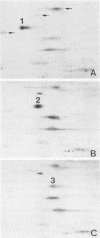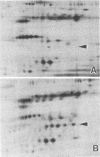Abstract
Five isolates of Cryptosporidium parvum collected from human, horse, and calf sources were compared for differences in sporozoite protein patterns by using two-dimensional gel electrophoresis. Silver-stained two-dimensional gels contained over 300 protein spots from detergent-solubilized sporozoites. A distinguishing 106-kilodalton peptide that shifted in isoelectric point was detected in four of the five isolates. Computerized two-dimensional gel analysis was performed to obtain objective quantitation of the pI shift. Three of these four isolates could be differentiated from one other by the pI shift in this peptide. The fifth isolate was distinguished by the absence of the 106-kilodalton peptide and the presence of a 40-kilodalton peptide that was not observed in any other isolate.
Full text
PDF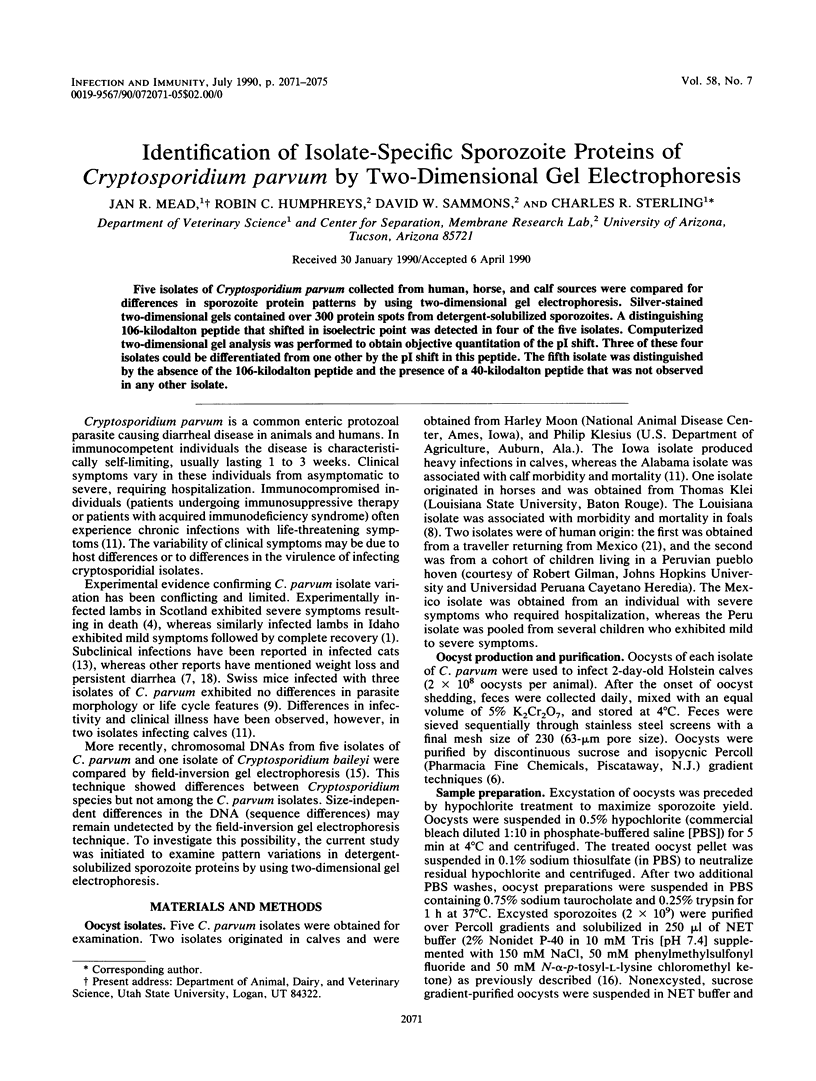
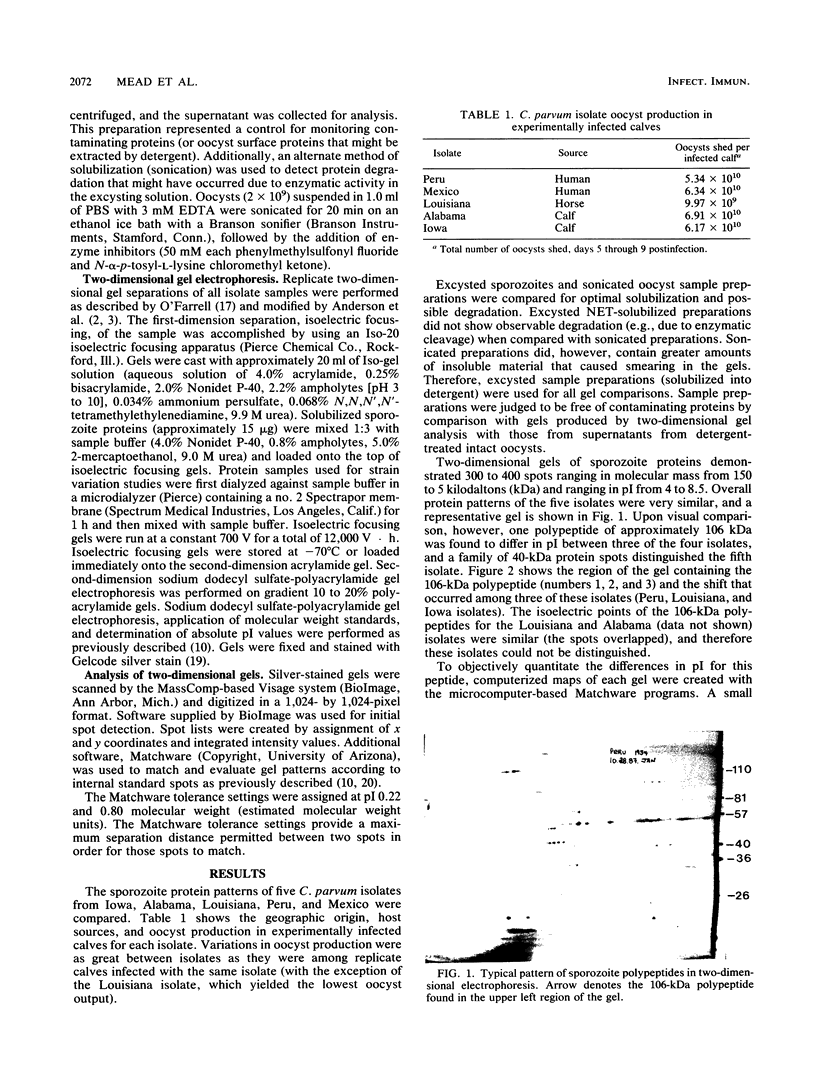
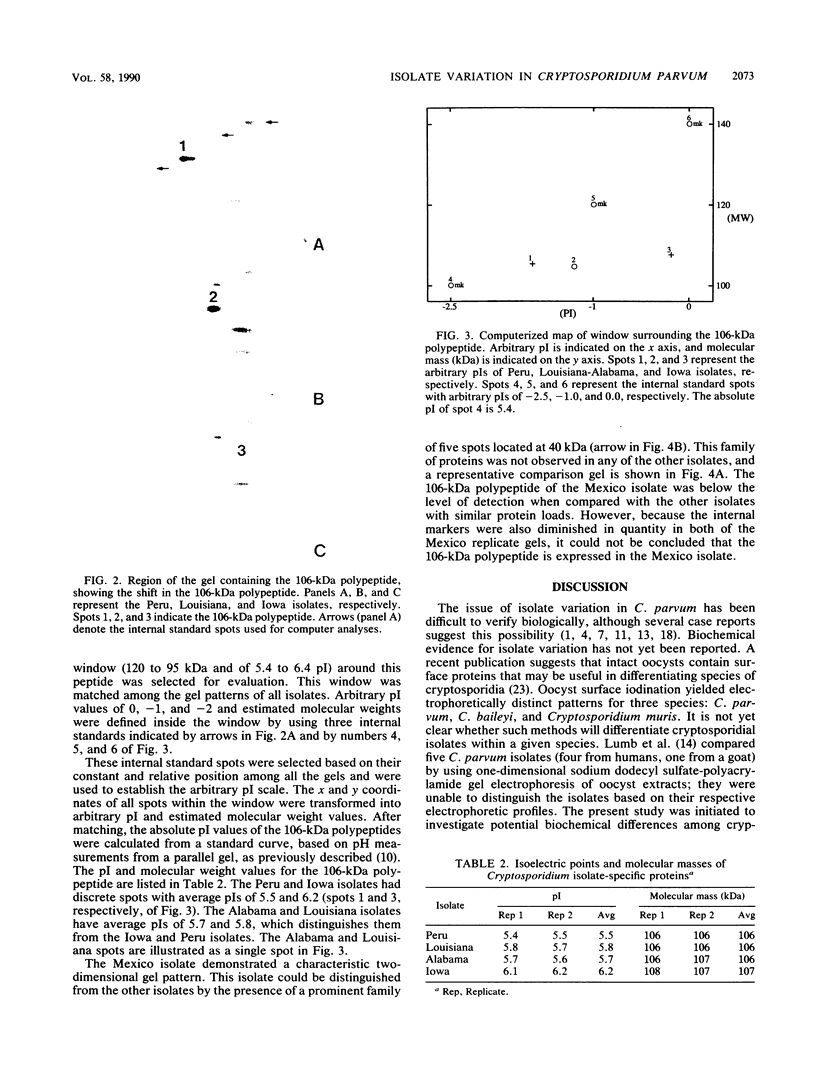
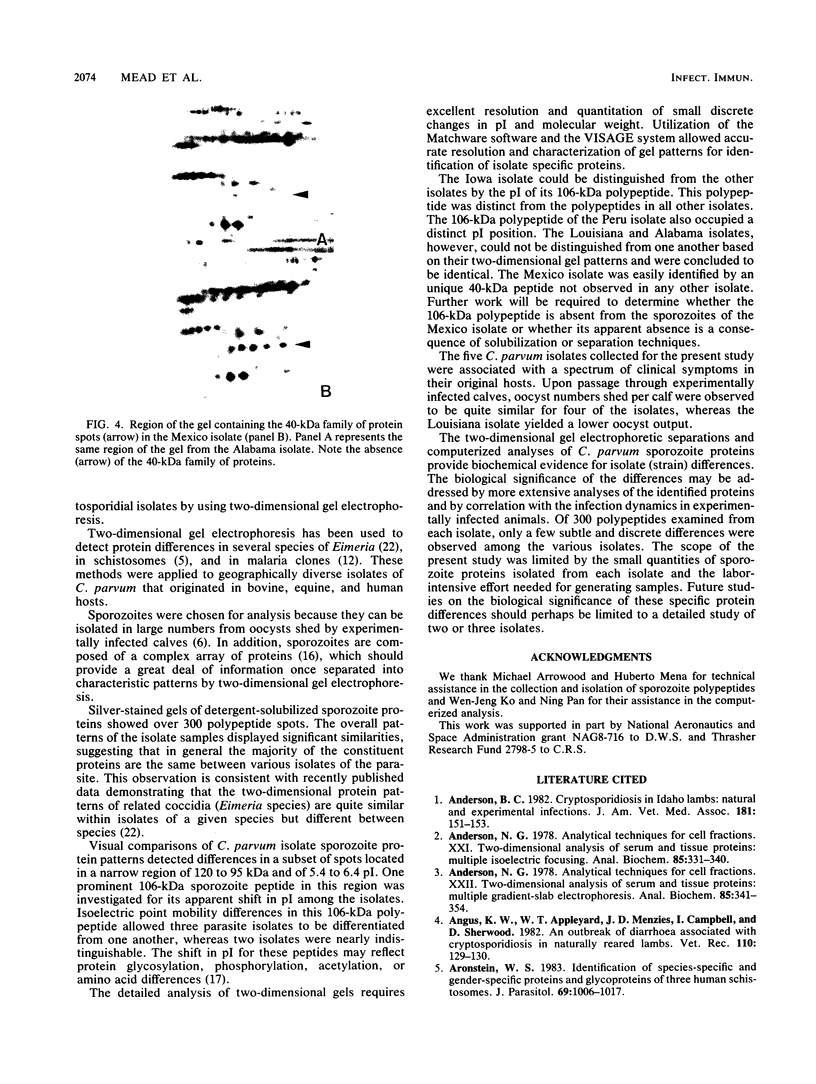
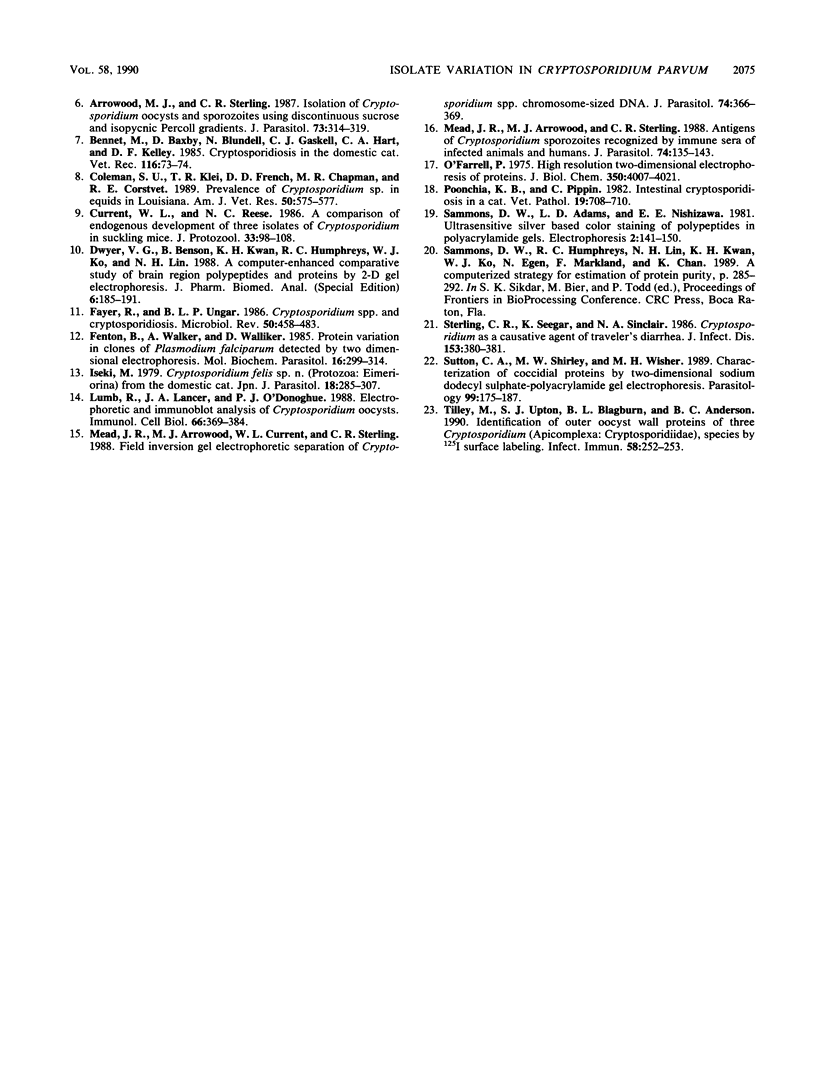
Images in this article
Selected References
These references are in PubMed. This may not be the complete list of references from this article.
- Anderson B. C. Cryptosporidiosis in Idaho lambs: natural and experimental infections. J Am Vet Med Assoc. 1982 Jul 15;181(2):151–153. [PubMed] [Google Scholar]
- Anderson N. G., Anderson N. L. Analytical techniques for cell fractions. XXI. Two-dimensional analysis of serum and tissue proteins: multiple isoelectric focusing. Anal Biochem. 1978 Apr;85(2):331–340. doi: 10.1016/0003-2697(78)90229-4. [DOI] [PubMed] [Google Scholar]
- Anderson N. L., Anderson N. G. Analytical techniques for cell fractions. XXII. Two-dimensional analysis of serum and tissue proteins: multiple gradient-slab gel electrophoresis. Anal Biochem. 1978 Apr;85(2):341–354. doi: 10.1016/0003-2697(78)90230-0. [DOI] [PubMed] [Google Scholar]
- Anderson N. L., Parish N. M., Richardson J. P., Pearson T. W. Comparison of African trypanosomes of different antigenic phenotypes, subspecies and life cycle stages by two-dimensional gel electrophoresis. Mol Biochem Parasitol. 1985 Sep;16(3):299–314. doi: 10.1016/0166-6851(85)90072-6. [DOI] [PubMed] [Google Scholar]
- Angus K. W., Appleyard W. T., Menzies J. D., Campbell I., Sherwood D. An outbreak of diarrhoea associated with cryptosporidiosis in naturally reared lambs. Vet Rec. 1982 Feb 6;110(6):129–130. doi: 10.1136/vr.110.6.129. [DOI] [PubMed] [Google Scholar]
- Aronstein W. S., Strand M. Identification of species-specific and gender-specific proteins and glycoproteins of three human schistosomes. J Parasitol. 1983 Dec;69(6):1006–1017. [PubMed] [Google Scholar]
- Arrowood M. J., Sterling C. R. Isolation of Cryptosporidium oocysts and sporozoites using discontinuous sucrose and isopycnic Percoll gradients. J Parasitol. 1987 Apr;73(2):314–319. [PubMed] [Google Scholar]
- Bennett M., Baxby D., Blundell N., Gaskell C. J., Hart C. A., Kelly D. F. Cryptosporidiosis in the domestic cat. Vet Rec. 1985 Jan 19;116(3):73–74. doi: 10.1136/vr.116.3.73. [DOI] [PubMed] [Google Scholar]
- Coleman S. U., Klei T. R., French D. D., Chapman M. R., Corstvet R. E. Prevalence of Cryptosporidium sp in equids in Louisiana. Am J Vet Res. 1989 Apr;50(4):575–577. [PubMed] [Google Scholar]
- Current W. L., Reese N. C. A comparison of endogenous development of three isolates of Cryptosporidium in suckling mice. J Protozool. 1986 Feb;33(1):98–108. doi: 10.1111/j.1550-7408.1986.tb05567.x. [DOI] [PubMed] [Google Scholar]
- Fayer R., Ungar B. L. Cryptosporidium spp. and cryptosporidiosis. Microbiol Rev. 1986 Dec;50(4):458–483. doi: 10.1128/mr.50.4.458-483.1986. [DOI] [PMC free article] [PubMed] [Google Scholar]
- Lumb R., Lanser J. A., O'Donoghue P. J. Electrophoretic and immunoblot analysis of Cryptosporidium oocysts. Immunol Cell Biol. 1988 Oct-Dec;66(Pt 5-6):369–376. doi: 10.1038/icb.1988.48. [DOI] [PubMed] [Google Scholar]
- Mead J. R., Arrowood M. J., Current W. L., Sterling C. R. Field inversion gel electrophoretic separation of Cryptosporidium spp. chromosome-sized DNA. J Parasitol. 1988 Jun;74(3):366–369. [PubMed] [Google Scholar]
- Mead J. R., Arrowood M. J., Sterling C. R. Antigens of Cryptosporidium sporozoites recognized by immune sera of infected animals and humans. J Parasitol. 1988 Feb;74(1):135–143. [PubMed] [Google Scholar]
- O'Farrell P. H. High resolution two-dimensional electrophoresis of proteins. J Biol Chem. 1975 May 25;250(10):4007–4021. [PMC free article] [PubMed] [Google Scholar]
- Poonacha K. B., Pippin C. Intestinal cryptosporidiosis in a cat. Vet Pathol. 1982 Nov;19(6):708–710. doi: 10.1177/030098588201900616. [DOI] [PubMed] [Google Scholar]
- Sterling C. R., Seegar K., Sinclair N. A. Cryptosporidium as a causative agent of traveler's diarrhea. J Infect Dis. 1986 Feb;153(2):380–381. doi: 10.1093/infdis/153.2.380. [DOI] [PubMed] [Google Scholar]
- Sutton C. A., Shirley M. W., Wisher M. H. Characterization of coccidial proteins by two-dimensional sodium dodecyl sulphate-polyacrylamide gel electrophoresis. Parasitology. 1989 Oct;99(Pt 2):175–187. doi: 10.1017/s0031182000058613. [DOI] [PubMed] [Google Scholar]
- Tilley M., Upton S. J., Blagburn B. L., Anderson B. C. Identification of outer oocyst wall proteins of three Cryptosporidium (Apicomplexa: Cryptosporidiidae) species by 125I surface labeling. Infect Immun. 1990 Jan;58(1):252–253. doi: 10.1128/iai.58.1.252-253.1990. [DOI] [PMC free article] [PubMed] [Google Scholar]




